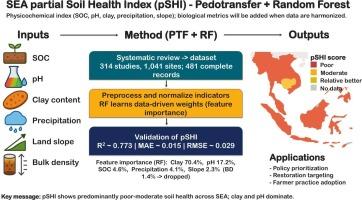基于理化指标的部分土壤健康指数在东南亚的退化制图
IF 5
2区 农林科学
Q1 SOIL SCIENCE
引用次数: 0
摘要
评估东南亚(SEA)的土壤退化具有挑战性,因为大多数研究都是针对具体国家和指标的,依赖于不同的指标,阻碍了对土壤健康的区域综合看法。为了解决这一差距,开发了区域校准的部分土壤健康指数(pSHI),将广泛可用的物理化学指标-土壤有机碳(SOC),体积密度(BD), pH,降水,坡度和粘土-整合到一个统一的框架中。通过系统评价收集区域数据集,利用土壤传递函数(PTF)和随机森林(RF)对指标进行整合和权重建模。最终模型显示出较强的有效性(R2 ~ 0.773; MAE ~ 0.015; RMSE ~ 0.029),其中粘土(70.4%)和pH(17.2%)主导信号,其次是SOC(4.6%)、降水(4.1%)和坡度(2.3%);BD(1.4%)可忽略不计,排除在外。虽然局限于物理化学属性,但pSHI捕获了土壤健康的广泛变化,而不是单个参数的孤立变化。在整个东南亚,pSHI值主要表明土壤健康状况为中差,代表性范围为:柬埔寨0.44-0.45(中等);马来西亚0.31-0.34,缅甸0.35,越南0.29-0.41(较差);印度尼西亚0.27-0.45,老挝0.33-0.42,菲律宾0.30-0.45,泰国0.31-0.45(中差)。pSHI提供了一种可扩展的工具来诊断退化,确定修复的优先顺序,并支持区域土壤保持政策;随着统一数据集的出现,可以将生物指标纳入其中。本文章由计算机程序翻译,如有差异,请以英文原文为准。

Degradation mapping in Southeast Asia using a partial soil health index based on physicochemical indicators
Assessing soil degradation in Southeast Asia (SEA) is challenging because most studies are country-specific and indicator-based, relying on disparate metrics that hinder a regionally integrated view of soil health. To address this gap, a regionally calibrated partial Soil Health Index (pSHI) was developed to integrate widely available physicochemical indicators—soil organic carbon (SOC), bulk density (BD), pH, precipitation, slope, and clay—into a unified framework. A regional dataset assembled via systematic review was modeled using a pedotransfer function (PTF) coupled with Random Forest (RF) to integrate and weight indicators. The final model showed strong validation (R2 ∼ 0.773; MAE ∼ 0.015; RMSE∼0.029), with clay (70.4 %) and pH (17.2 %) dominating the signal, followed by SOC (4.6 %), precipitation (4.1 %), and slope (2.3 %); BD (1.4 %) was negligible and excluded. Although limited to physicochemical attributes, the pSHI captures broad shifts in soil health rather than isolated changes in single parameters. Across SEA, pSHI values indicate predominantly poor–moderate soil health, with representative ranges: Cambodia 0.44–0.45 (moderate); Malaysia 0.31–0.34, Myanmar 0.35, and Vietnam 0.29–0.41 (poor); and Indonesia 0.27–0.45, Laos 0.33–0.42, the Philippines 0.30–0.45, and Thailand 0.31–0.45 (poor–moderate). The pSHI provides a scalable tool to diagnose degradation, prioritize restoration, and support regional soil-conservation policy; biological indicators can be incorporated as harmonized datasets emerge.
求助全文
通过发布文献求助,成功后即可免费获取论文全文。
去求助
来源期刊

Applied Soil Ecology
农林科学-土壤科学
CiteScore
9.70
自引率
4.20%
发文量
363
审稿时长
5.3 months
期刊介绍:
Applied Soil Ecology addresses the role of soil organisms and their interactions in relation to: sustainability and productivity, nutrient cycling and other soil processes, the maintenance of soil functions, the impact of human activities on soil ecosystems and bio(techno)logical control of soil-inhabiting pests, diseases and weeds.
 求助内容:
求助内容: 应助结果提醒方式:
应助结果提醒方式:


